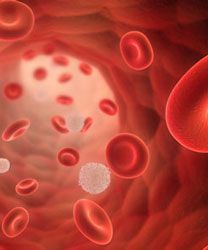Article
Interferon Continues to Show Promise as Myelofibrosis Option
Author(s):
Patients with myeloproliferative neoplasm‒associated myelofibrosis had prolonged treatment duration and improved survival compared with historical controls when treated with pegylated interferon alfa-2a.
mcl

Patients with myeloproliferative neoplasm‒associated myelofibrosis (MF) had prolonged treatment duration and improved survival compared with historical controls when treated with pegylated interferon alfa-2a (peg-IFN-alfa-2a), according to findings of a French trial presented at the 2017 ASH Annual Meeting.1
A cohort comprising patients with primary and secondary MF had a median treatment duration of 39 months and median overall survival (OS) of 7.4 years. The type of driver mutation and the reason for discontinuing treatment (intolerance vs resistance) significantly affected OS.
“This large observational study shows that pegylated interferon alfa-2a is a clear option in the management of patients with myelofibrosis,” said Jean-Christophe Ianotto, MD, a hematologist at Brest University Hospital Center in France. “Patients with intermediate-2 and high Dynamic International Prognostic Scoring System (DIPSS) score had longer-than-expected survival compared with reference cohorts of patients treated with conventional therapy.”
Ianotto added, “Stopping pegylated interferon alfa-2a before 2 years for intolerance or resistance reduced the OS, regardless of subsequent therapy. The presence of additional mutations is correlated with poorer survival.”
The findings represented an update of an ongoing observational study from the French Intergroup of Myeloproliferative Neoplasms of peg-IFN-alfa-2a in patients with primary and secondary MF. A previous report on 62 patients with mean follow-up of 26 months showed high response rates and acceptable toxicity, particularly among patients with early-stage disease.2
The updated report was based on an analysis performed after a median follow-up of 58 months. Ianotto said that 32 patients died during follow-up, and the cohort had a 5-year actuarial survival of 55%. Seven patients died after transformation to acute myeloid leukemia and 1 to a solid tumor, 7 from MF progression, 5 from graft-versus-host disease after stem cell transplantation, 5 from cardiovascular complications, and 4 from infectious complications.
Survival improved with DIPSS risk score. Patients with poor-risk disease had a median OS of 4.6 years, improving to 6.9 and 8.9 years for patients with intermediate-1 and -2 risk scores. Patients with low-risk disease by DIPSS had yet to reach median survival.
Earlier initiation of peg-IFN-alfa-2a was correlated with improved survival. Patients who received IFN as second-line therapy had a median OS of 4.3 months. The median had yet to be reached in patients who received the treatment as initial therapy (P =.02).
Ianotto said that 45 patients stopped treatment, 25 because of resistance—after a median treatment duration of 20 months—and 20 because of intolerance after a median of 12 months. Patients who discontinued treatment for any reason had worse survival compared with those who remained on treatment (P <.00001); however, patients who stopped because of resistance had a particularly steep drop-off in survival (median, 2.7 years). Patients who stopped treatment because of intolerance had a median OS of 5.7 years.
Mutation status also affected outcomes. Prior to initiating treatment with peg-IFN-alfa-2a, patients had a median JAK2V617F allele burden of 67%. Subsequently, the allele burden declined by more than 20% in 15 patients and by more than 50% in 10 patients. Sequential analyses available for 27 patients showed that the median allele burden declined from 57.3% at baseline to 29% after 3 years of treatment.
Next-generation sequencing in 49 patients revealed additional mutations in 28 patients (57.1%). There was a total of 44 additional mutations, 47% of which affected epigenetic regulation. Additional mutations were more common in patients who stopped treatment (68% vs 33% for those patients who remained on treatment). HMR mutations were identified in 9 patients (18%).
Patients with additional mutations had a median OS of 6.1 years, which trended toward a statistically significant decrement (P =.06). Patients with high-molecular-risk mutations (ASXL1, EZH2, SRSF2, IDH1/2) had a median survival of 4.9 years (P =.068).
References
- Ianotto JC, Chauveau A, Boyer-Perrard F, et al. Long term outcome of patients with MPN-associated myelofibrosis treated with peg-interferon-α2a, a French Intergroup of Myeloproliferative Neoplasms (FIM) study. In: Proceedings from the 59th ASH Annual Meeting and Exposition; December 9-12, 2017; Atlanta, GA. Abstract 323.
- Ianotto JC, Boyer-Perrard F, Gyan E, et al. Efficacy and safety of pegylated-interferon a-2a in myelofibrosis: a study by the FIM and GEM French cooperative groups. Br J Haematol. 2013;162(1):783-791. doi:10.1111/bjh.12459.







%20(2)%201-Recovered-Recovered-Recovered-Recovered-Recovered.jpg?fit=crop&auto=format)
%20(2)%201-Recovered-Recovered-Recovered-Recovered-Recovered.jpg?fit=crop&auto=format)
